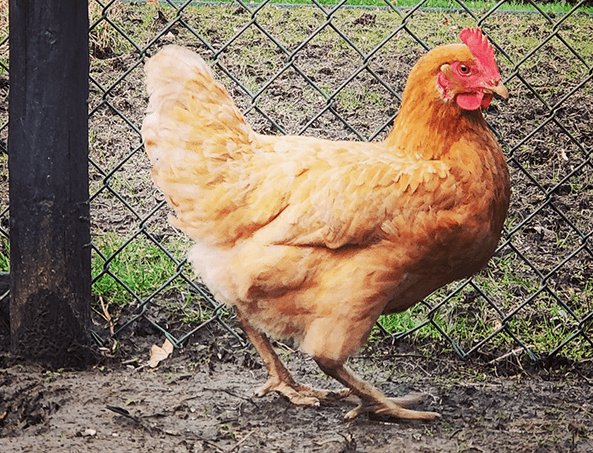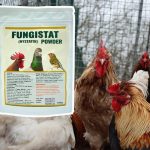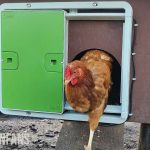Can You Overfeed Chickens?

If your chickens are free-ranging or have access to food 24/7, you don’t have a clue how much they eat during the day. Is it dangerous to provide them with an all-you-can-eat buffet?
Can chickens overeat and become overweight or develop a fatty liver? And how much should your chickens eat during the day to stay happy and healthy?
Let’s find out.
Can a chicken overeat?
In general, chickens can not overeat because they tend to stop eating when their crop is full. When a chicken eats, the food does not travel directly to its stomach but gets stored in the crop before moving further into the digestive tract.
A chicken’s crop is located slightly to the right side of the breastbone, at the bottom of its neck.

As chickens tend to eat very fast, the food gets stored in a ‘pocket’, preventing overeating. When their crop is full, chickens stop eating until the food digests and the crop shrinks.
But as chickens are living animals, they don’t come with guarantees. There have been chicken keepers reporting about (primarily young) chickens eating themselves to death, but it’s very rare; most chickens stop eating when the crop is full.
After a good night’s rest, your chickens may seem starving as they attack the feeder like wild animals. Or it looks like you have to fill up their feeder more each day, and it’s still empty in the late afternoon. That doesn’t necessarily mean your chickens are overeating.
Most common explanations as to why you think your chicken is overeating:
- Spilled food
- Visitors from outside the coop
Spilled food
Things can get quite messy inside a chicken run and coop. So, you won’t always notice spilled food because it has been scratched under the ground or inside the bedding. Chickens can be pretty chaotic when eating. They knock over the eating tray or feeder, and food gets spilled. A hanging feeder can be a solution. Place it at neck level, and your chickens peck the feed out without spilling or knocking over the feeder.

You can easily DIY a no-waste feeder by purchasing a large plastic bin (type Tupperware). Drill some holes in the bin, glue PVC pipes in place, and hang the bin inside the run. Not only will this type of feeder reduce food spillage, but it will also keep the food dry.
Visitors from outside the coop
Non-poultry visitors, like songbirds, chipmunks, rats, or squirrels, will enjoy eating the chicken feed you leave outside. When the feeding tray is always empty, you might think your hens could be overeating. But it’s much more likely to look for outside visitors as the reason why the feed gets eaten.
You need to secure the run for ‘predators’ or rodents to prevent this from happening. Place the feed out of sight or inside a covered tunnel and think about covering the run with netting. Or purchase a covered and automatic chicken feeder, so the food only gets eaten by your chickens. There are plenty of anti-rodent feeders available on the market, so pick the one that suits your needs.
Is my chicken overweight?
A chicken’s weight depends on its breed and gender. Orpingtons weigh more than leghorns, and roosters weigh more than hens. We’ll get you started by giving some examples of the average weight of a female chicken per breed.
| Breed | Average weight (hen) |
| Leghorn | 5 pounds (2.2 kg) |
| Orpington | 6.9 pounds (3.1 kg) |
| Silkie | 3 pounds (1.4 kg) |
| Araucana | 5.5 pounds (2.5 kg) |
| Isa Brown | 5 pounds (2.2 kg) |
| Marans | 6.3 pounds (2.8 kg) |
| Barnevelder | 6.7 pounds (3 kg) |
| Australorp | 6 pounds (2.7 kg) |
| Polish | 4.4 pounds (2 kg) |
When you suspect your chicken is too fat, feel the keel bone, a prominent bone extending outward from the breast. You should be able to feel the bone, and too much fat makes that impossible. However, this keel bone test does not work when you suspect your hen has a fatty liver. In that case, most of the hen’s fat is located near the abdomens. When you suspect your chicken is overweight, it’s best to consult a vet.

Obesity in chickens is generally NOT caused by overeating but by feeding them the wrong food. Like all animals, chickens need a balanced diet to keep themselves healthy. But they tend to eat what they like most, not necessarily what’s good for them. It’s much to be compared with a child that prefers candy over vegetables.
Never feed your chickens more than 10% of their daily feed in snacks or table scraps. They don’t need any treats at all, actually.
Next to a balanced diet, ensure plenty of space for your chickens to get enough exercise. Check out our chicken coop and run size calculator.
Dangers of obesity in chickens
- Fatty liver disease
- Heat stroke
- Troubles with egg production and fertility
Fatty liver disease
Fatty Liver Hemorrhagic Syndrome (FLHS) is a metabolic condition and is a significant cause of mortality in laying hens. Chickens with FLHS have large amounts of fat in the liver or abdomen, resulting in an enlarged liver. This condition kills young egg-laying hens when left untreated due to blood loss caused by internal hemorrhages in the liver. This causes sudden death before showing any apparent symptoms.
Hens dying of FLHS are mostly overweight with a pale comb and have lived on an excessive energy intake. If diagnosed early, a chicken can recover by adjusting the carbohydrate-to-fat ratio in its diet.
heat Stroke
Hot weather and heat waves can be a real threat to chickens with obesity due to the additional fat in their abdomen. Chickens have no sweat glands and rely on their respiratory system to cool down. Cooling down your chickens during a heatwave is essential, but even more for overweight hens. As the abdominal fat gets in the way of breathing properly, your hen can’t cool herself down and may suffer a heat stroke and die.
Troubles with egg production and fertility
Obese chickens have higher chances of developing fertility problems and are more likely to have issues with their egg production. Even prolapsed vent and egg-binding are problems that often occur to overweight hens. When a hen is straining to lay an egg, this can result in internal bleeding.
Am I Overfeeding my chickens?
As there are many different chicken breeds, it’s hard to provide a rule of thumb regarding how much you should feed your chicken. Roughly said, an adult regular-sized chicken eats approximately 1.50 pounds to 1.75 pounds per week. That means around 1/4 pound per day.
Feed your chickens twice a day. The first time in the morning after they leave the chicken coop. A second time a couple of hours before sunset, before they go to bed. It would be best never to let a chicken go to roost with an empty stomach, as it can influence their egg production, and hungry chickens are restless chickens.
Be careful when providing snacks and table scrabs next to pellet feed. Treats should be given in moderation, and never give more than 10% in their daily feed in snacks or leftovers.
My chickens always look hungry. Am I underfeeding them?
When filling their feeder every day, your chickens won’t be underfed. But keep an eye on your flock as sick or stressed chickens won’t eat like they usually do.
A chicken can go no longer than 4-5 days without food, so try to tube feed a liquid diet to chickens who refuse to eat and consult a vet to resolve any health issues.
If you want to learn more about why chickens always seem hungry, check out our article.





















